I’ve officially reached the end-game of Tom Clancy’s The Division, which was something of a bittersweet moment in many ways, but it does mean I can now crack on with my Full Review type witterings. Lucky you, eh!? In order to not repeat myself too much, I’ll try not to go over the same ground as my First and Second Impressions pieces, but obviously some degree of repetition’s inevitable so, like, apologies in advance.
Tom Clancy’s The Division was, by almost any conceivable measurement, a hugely anticipated Next-Gen release, and in many ways it’s been an ever-present “event” hovering over Next-Gen consoles since their own launch nearly two and a half years ago. For me, it was a prospect that sealed my own decision to make the generational leap (and I know I’m not alone in that), so it’s fair to say all of the above created a genuinely high degree of attention and – not for nothing – pressure. As Gamers, we’ve been here before though, and we know that sometimes the hype-train turns out to be nothing but a shitty, run-down locomotive with broken seats and an overwhelming stench of piss emanating from the toilets, so we’re often naturally sceptical of such things.
Right off the bat, I’ll happily declare that The Division’s not a run-down locomotive (and there’s certainly no overwhelming stench of piss), but whether it’s actually one of those super-duper high speed bullet trains – or just a perfectly acceptable commuter train that gets the job done – will largely depend upon a few things. Because, in a way (and without wanting to sound like voice-over Dude from the Law and Orders), Tom Clancy’s The Division is three slightly-distinct-yet-overlapping Gaming experiences so, depending on your own circumstances, you might not get the full experience, or you might (for example) find one of the three outstanding but the other two decidedly “meh”. Obviously, each of those experiences happen within the same general build, or architecture if you like, so it’s this that I’ll turn to first.
And it’s certainly impressive architecture, as far as I’m concerned. I’d even go as far as to say it’s some of the most impressive I’ve ever seen, and it’s a soaring, sweeping edifice – as beautiful and ornate as it is solid and sturdy. The architecture analogy’s particularly fitting because, from a visual point of view, it’ll likely be the City of New York, with its iconic cityscape and Skyline, that’ll immediately wow you as you take your first tentative steps into The Division’s world.
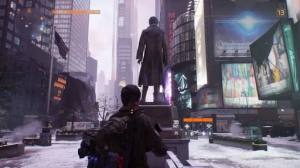 Make no mistake, The Division is a visual tour de force, and it’s positively overflowing with a sense of atmosphere that’s breathtaking in both its scope and execution. Every corner, every stoop, every shop front will be an integral part of your experience, where even the weather will alter your mood and – more importantly – how you play the game. An alley that you were happy to use as a short-cut in the crisp light of a winter’s morning suddenly becomes a place of danger as night falls and the snow whips blizzard-like across the screen, severely restricting your ability to see more than a few meters in front of you.
Make no mistake, The Division is a visual tour de force, and it’s positively overflowing with a sense of atmosphere that’s breathtaking in both its scope and execution. Every corner, every stoop, every shop front will be an integral part of your experience, where even the weather will alter your mood and – more importantly – how you play the game. An alley that you were happy to use as a short-cut in the crisp light of a winter’s morning suddenly becomes a place of danger as night falls and the snow whips blizzard-like across the screen, severely restricting your ability to see more than a few meters in front of you.
There is a real, genuine sense of foreboding in NYC’s post-outbreak Streets, and there were times when I was literally on the edge of my seat, senses heightened, just waiting for an attack from one of the city’s many dark corners, or from behind any of the abandoned cars that fill its streets. To walk in The Division’s world is to take a serious risk, and unlike most other Sandbox-type games, there are no pleasant strolls from A to B. That’s obviously a pain in the arse if you’re trying to get to your chosen mission or activity without depleting your ammo (or getting dead), but it is very much in keeping with the world (and scenario) that The Division asks us to accept, and in turn makes that self-same acceptance that much easier.
 Given you’re tasked with ‘taking New York City back’ one hard-fought block at a time, I really liked that you often had to exit a safehouse with that exact mentality. I also really liked how actually completing the side-missions and encounters had an impact on the area, with it gradually becoming less dangerous, less menacing as you loosened the grip of the gangs roaming the streets and alleyways. It’s not an original concept (see Far Cry, Just Cause, etc, etc) but for me, it worked exceptionally well in The Division, being both a part of the gameplay, and woven into the very fabric of the game’s narrative and visuals. Even more impressive is that this world actually functions outside of your own particular journey, increasing the sense that you’re a part of a real, organic city. Many times I’ve stumbled across two rival gangs fighting over a disputed Street corner, or engaged in general fisticuffs, and even though rationally I know that’s just the result of a particular string of code, it’s impact on the illusion of an NYC in chaos is undeniable.
Given you’re tasked with ‘taking New York City back’ one hard-fought block at a time, I really liked that you often had to exit a safehouse with that exact mentality. I also really liked how actually completing the side-missions and encounters had an impact on the area, with it gradually becoming less dangerous, less menacing as you loosened the grip of the gangs roaming the streets and alleyways. It’s not an original concept (see Far Cry, Just Cause, etc, etc) but for me, it worked exceptionally well in The Division, being both a part of the gameplay, and woven into the very fabric of the game’s narrative and visuals. Even more impressive is that this world actually functions outside of your own particular journey, increasing the sense that you’re a part of a real, organic city. Many times I’ve stumbled across two rival gangs fighting over a disputed Street corner, or engaged in general fisticuffs, and even though rationally I know that’s just the result of a particular string of code, it’s impact on the illusion of an NYC in chaos is undeniable.
Once you move past the graphics and visual flair of The Division, it’s likely that the next thing you’ll notice is how fantastic the MECHANICS of the game feel. It’s possible that after nearly 30 years of Gaming I’ve shot something in the region of a bajillionty-twelve things in the murrrrfuckin’ face (give-or-take), so it’s impressive that doing so in The Division felt fresh and exciting. There’s a solidness to it that’s hard to describe, a kind of tangible and absorbing feedback loop that makes it feel like the most rewarding thing in the world. Which is actually quite lucky really, because by Christ you’re going to be shooting a lot of people in the face. As you’d expect playing as a recently activated sleeper agent in a world gone to shit, you’ll immediately be putting those excellent shooting mechanics to the test, and if you don’t want to get very dead, very quickly, you’ll also be utilising The Division’s second major feature: the (usually) fantastic cover mechanics.
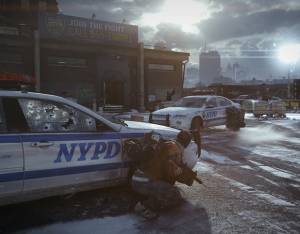 The Cover Mechanics are – for the most part – reliable, intuitive and solid, which is just as well really because you’re going to need ’em to be. In a world where you’re heavily outnumbered, and often (literally) caught between two groups of people who would very much like to fuck your shit up, it’s imperative that you tip the odds in your favour any way you can. This is where “cover”, and more accurately moving between it, becomes one of your greatest tactical advantages, and Ubi/Massive have provided a taking/switching between cover masterclass. Thanks to a handy little inclusion in The Division, you can pan the camera around, and when you arrive on an object you can take cover behind, a little square with an “X” in it will appear on said object. If you’re already behind cover, a little line will also appear between the two points, allowing you to plan and execute cover-to-cover moves with relative speed and ease, even in the heat of battle.
The Cover Mechanics are – for the most part – reliable, intuitive and solid, which is just as well really because you’re going to need ’em to be. In a world where you’re heavily outnumbered, and often (literally) caught between two groups of people who would very much like to fuck your shit up, it’s imperative that you tip the odds in your favour any way you can. This is where “cover”, and more accurately moving between it, becomes one of your greatest tactical advantages, and Ubi/Massive have provided a taking/switching between cover masterclass. Thanks to a handy little inclusion in The Division, you can pan the camera around, and when you arrive on an object you can take cover behind, a little square with an “X” in it will appear on said object. If you’re already behind cover, a little line will also appear between the two points, allowing you to plan and execute cover-to-cover moves with relative speed and ease, even in the heat of battle.
And, going back to the whole post-crisis NYC thing, there’s a lot of cover to use, from abandoned cars, to security cordons, to the very architecture of the city. It’s worth mentioning here, I think, that this works exceptionally well from a credibility standpoint. Whereas in many games cover feels like it’s been placed there for you to use (“Oh look, a random concrete block in the middle of an otherwise empty Street…”) in The Division, because you can use almost everything, and because you can plot your route using pretty much anything, you really feel like you’re using the environment to your advantage in a natural, tactically open way.
Again, Urban Warfare ain’t a new thing in Video Games, neither is the whole ‘things having gone a bit Pete Tong’ concept, but the marriage of the two things here, and the way they’ve been interwoven by Ubi/Massive into all aspects of the game, create an incredibly immersive – and eminently payable – world.
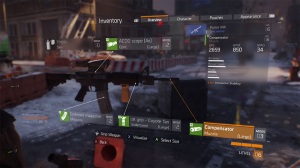 On such foundations, The Division builds one of the most addictive Gear/Loot/Upgrading systems I’ve ever come across, and even though shooting people in the face is rewarding in and of itself, you’ll be given more incentive to do so in the form of loot drop-age. I’m currently in the midst of training a particularly stubborn puppy – so it’s possible I’m more conscious of ‘conditioning’ than I’d normally be – but I honestly can’t think of a better way to describe the psychology of the loot in The Division. See, fairly frequently when you down an enemy, you’ll hear a little sound (and on the PS4, it comes right out of the damn controller) which will signify that they’ve dropped a particularly interesting piece of loot as they shuffled from this mortal coil. It might be a Weapon, a mod, or any of the various pieces of Gear you can outfit your agent with, and over time (say, like three minutes) this becomes every bit as powerful as Pavlov’s bell. To the point where I’m pretty sure I actually salivate when I hear that sound.
On such foundations, The Division builds one of the most addictive Gear/Loot/Upgrading systems I’ve ever come across, and even though shooting people in the face is rewarding in and of itself, you’ll be given more incentive to do so in the form of loot drop-age. I’m currently in the midst of training a particularly stubborn puppy – so it’s possible I’m more conscious of ‘conditioning’ than I’d normally be – but I honestly can’t think of a better way to describe the psychology of the loot in The Division. See, fairly frequently when you down an enemy, you’ll hear a little sound (and on the PS4, it comes right out of the damn controller) which will signify that they’ve dropped a particularly interesting piece of loot as they shuffled from this mortal coil. It might be a Weapon, a mod, or any of the various pieces of Gear you can outfit your agent with, and over time (say, like three minutes) this becomes every bit as powerful as Pavlov’s bell. To the point where I’m pretty sure I actually salivate when I hear that sound.
And the gear, weapons and mods themselves are part of an equally addictive process in The Division: your agent’s build. Whilst there is a straight forward XP/levelling-up system in the game, your primary concern will be an array of Stats that signify and determine your agent’s proficiency in certain categories. At its most basic, these are Firearms, Stamina and Electronics, and most of your gear, weapons and mods will have an impact on one or more of these core stats.
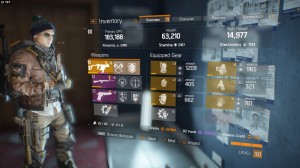 More cunningly, virtually nothing exists in isolation, so it’s very rarely as simple as picking up a particularly kick-ass vest and just equipping it before going on your next killing spree. You’ll need to properly assess how that vest works within your current set-up, for example, whether its increase to your Armor, and Firearms/Damage Per Second (DPS) stats is worth the drop it causes in your Stamina (Health) one. Moreover, you can probably offset that drop by re-assessing the other gear you’ve got equipped, seeing if a particular holster you’d held onto fits into a newer build with that vest as the centrepiece. As you get further in the game, it’s even possible that said vest will have a mod-slot, meaning that you can actually boost the Stamina stat by popping a mod in there that you’d picked up from shooting some other dude in the face.
More cunningly, virtually nothing exists in isolation, so it’s very rarely as simple as picking up a particularly kick-ass vest and just equipping it before going on your next killing spree. You’ll need to properly assess how that vest works within your current set-up, for example, whether its increase to your Armor, and Firearms/Damage Per Second (DPS) stats is worth the drop it causes in your Stamina (Health) one. Moreover, you can probably offset that drop by re-assessing the other gear you’ve got equipped, seeing if a particular holster you’d held onto fits into a newer build with that vest as the centrepiece. As you get further in the game, it’s even possible that said vest will have a mod-slot, meaning that you can actually boost the Stamina stat by popping a mod in there that you’d picked up from shooting some other dude in the face.
Long-story short, you’ll spend a fuck-load of your time continuously re-examining and re-evaluating your stuff as you continue your journey through the game, and you’ll be constantly chasing down that elusive piece of gear that fits into your build perfectly, or reworking everything to suit your current situation. In my Secondary Impressions piece, I called this Evil Genius Level Gaming Smack, because, to be honest, it fucking is. The combination of ‘the drop’, the build, and the changing needs of your agent is a compulsion – almost like a separate tactical minigame within The Division. Again, this isn’t necessarily an original concept, but like with much else in the game, it’s been executed with an extra little som’thin’-som’thin’ that elevates it beyond most of what has gone before it.
So, to sum up so far, The Division looks superb, it plays fantastically, and it contains enough addictive elements to keep you plenty busy outside of the core narrative aspects of the game. But what about those NARRATIVE aspects? Are they any good?
 Well, yes, but in my humble opinion they’re not nearly as awesome as everything I’ve already mentioned, and for me, they’re the weakest part of Tom Clancy’s The Division. Before I explain why, it’s worth reminding you of the ‘three distinct Gaming experiences’ thing I mentioned way back at the start. See, I completed the game as a lone-wolf, which it’s entirely possible to do, but the cost of that was a high degree of same-yness. Each of the game’s ‘Main’ missions is loosely tied to the overarching narrative, but they’re all very, very similar in practice. Whether you’re tracking down a particular scientist, or eliminating the leader of one of the city’s gangs, they’ll follow a very similar pattern, which – particularly when you’re lone-wolfing it – will involve basically the same approach and tactics every time.
Well, yes, but in my humble opinion they’re not nearly as awesome as everything I’ve already mentioned, and for me, they’re the weakest part of Tom Clancy’s The Division. Before I explain why, it’s worth reminding you of the ‘three distinct Gaming experiences’ thing I mentioned way back at the start. See, I completed the game as a lone-wolf, which it’s entirely possible to do, but the cost of that was a high degree of same-yness. Each of the game’s ‘Main’ missions is loosely tied to the overarching narrative, but they’re all very, very similar in practice. Whether you’re tracking down a particular scientist, or eliminating the leader of one of the city’s gangs, they’ll follow a very similar pattern, which – particularly when you’re lone-wolfing it – will involve basically the same approach and tactics every time.
It doesn’t necessarily get boring per se, but there’s certainly a sense of déjà vu to the proceedings. I tried mixing it up a bit, for shits and giggles as much as anything else, but it soon became apparent that on your own, there’s essentially one way to get shit done. Here’s where one of the separate-yet-overlapping doodahs comes into play because you can, and probably should, join up with other agents to tackle any and all of the Main missions. This can be with the real-life actual friends I’m told most people who aren’t me have, or with randoms via the inbuilt matchmaking tool. Doing so will undoubtedly create a degree of spontaneity and variety to missions that I didn’t find – so my experience is likely atypical, but I’m of the (decidedly old-school) opinion that Single Player Campaigns still matter. I mean, it’s great that I had the SP option, and it was a huge fucking relief that I could finish the game on my own, but doing so highlighted the weaknesses within the Narrative/Gameplay elements of The Division.
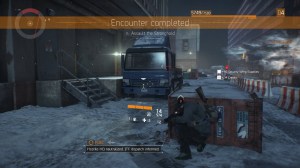 This was further compounded by the repetition inherent in the Side Missions and Encounters dotted around the map, and they basically consisted of three or four core types. Again, outside of main missions you can just generally mill around with other agents/friends in The Division, so the same variety/spontaneity caveats apply here too, but – whilst the side missions of open-world games often follow a three-or-four-catagories blueprint – it sort of felt more disappointing in The Division than it can do in other games.
This was further compounded by the repetition inherent in the Side Missions and Encounters dotted around the map, and they basically consisted of three or four core types. Again, outside of main missions you can just generally mill around with other agents/friends in The Division, so the same variety/spontaneity caveats apply here too, but – whilst the side missions of open-world games often follow a three-or-four-catagories blueprint – it sort of felt more disappointing in The Division than it can do in other games.
And finally for the Narrative bit, let’s look at the actual “story” of The Division. Those inverted commas are quite fitting because, unfortunately, there’s not much story to speak of, and there’s certainly no narrative pay-off that you won’t have seen coming from several miles away. Again, it’s often hard to maintain genuine ‘Narrative Tension’ in open-world type games (especially compared to linear, checkpoint based ones) but it is possible to make it work better than it did in The Division, I feel. Once more, this was more of a disappointment precisely because the game is so epic in some regards, yet a clichéd, painting-by-numbers approach to the narrative dragged it down like an anchor attached to mediocrity.
 The one redeeming feature here was, I think, the various collectibles scattered around the game – which did provide a degree of nuance and depth to the story The Division was trying to tell. They reminded me a lot of the various bits and pieces in Wolfenstein: The New Order, or Valiant Hearts in that they were interesting and informative in their own right, and ultimately worth collecting if you wished to pad out the story side of the game.
The one redeeming feature here was, I think, the various collectibles scattered around the game – which did provide a degree of nuance and depth to the story The Division was trying to tell. They reminded me a lot of the various bits and pieces in Wolfenstein: The New Order, or Valiant Hearts in that they were interesting and informative in their own right, and ultimately worth collecting if you wished to pad out the story side of the game.
Of course, it’s entirely possible that the majority of people who bought The Division give exactly no fucks about the story, and precisely because, for many people, it’s not a part of the game they’re likely to spend much time focusing on, and much less time thinking about. I am, of course, referring to THE DARK ZONE shenanigans.
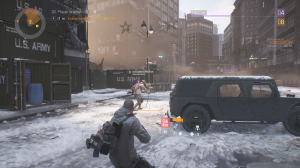 This is the third of the distinct-yet-overlapping experiences I’ve already alluded to, and it’s the bit that provides most of the overlap. The Dark Zone is The Division’s PvE and PvP zone, and like the non-Dark Zone stuff, you’re free to enter it alone, or with your Buddies. Aside from being impossible to say without some ominous soundtrack playing in your head, The Dark Zone (duh, duuhh DUH!) is the real proving ground of your agent, their gear and your combined skills. The enemies are a lot, lot tougher, you may find yourself at the mercy of other players, and any loot you do pick up will need to be extracted (because, contamination) before you actually get to keep it.
This is the third of the distinct-yet-overlapping experiences I’ve already alluded to, and it’s the bit that provides most of the overlap. The Dark Zone is The Division’s PvE and PvP zone, and like the non-Dark Zone stuff, you’re free to enter it alone, or with your Buddies. Aside from being impossible to say without some ominous soundtrack playing in your head, The Dark Zone (duh, duuhh DUH!) is the real proving ground of your agent, their gear and your combined skills. The enemies are a lot, lot tougher, you may find yourself at the mercy of other players, and any loot you do pick up will need to be extracted (because, contamination) before you actually get to keep it.
I’ve only briefly explored the DZ (certainly compared to the rest of the game) and it is exciting, and challenging, but it’s not – if I’m being honest – a real heap of fun if you’re on your own. To say the odds are stacked against you would be a massive understatement, and you’ll be limited in what you can get out of the experience.
For the record, it’s not just that I’m terrible (I have managed to take down a named elite and his entourage on my own), it’s just that, realistically, you’re likely to die. A lot. Given its relative cosiness, and given there’s less usable cover, for a single player, the DZ is basically a 360 degree theatre of death – where taking cover to fight one set of bad-ass dudes will just allow another set to fire round after round into your exposed, flailing arse. Your chances of surviving the onslaught that comes when you call in an extraction on your own are also very slim – and you’re only likely to extract stuff if you happen to survive long enough to arrive at an extraction that’s already taking place.
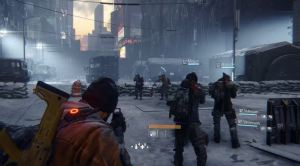 That said though, the Dark Zone element of The Division is a great idea, and it is well executed. It’s clearly not fair for me to blame Ubisoft for my lack of friends, and given I’m in the minority with that, I can certainly see how the Dark Zone will be the main draw for a lot of people. Even as a billy-no-mates, I’ve had some fun in there, and I’ve even made some temporary, fleeting friendships with other agents as we fought off hordes of bad guys at an extraction point. I’m not done with the DZ yet either (watch this space), and perhaps the fact that I’m still willing to go back in there (despite the tears and humiliation) is a testement to just how compelling it can be!?
That said though, the Dark Zone element of The Division is a great idea, and it is well executed. It’s clearly not fair for me to blame Ubisoft for my lack of friends, and given I’m in the minority with that, I can certainly see how the Dark Zone will be the main draw for a lot of people. Even as a billy-no-mates, I’ve had some fun in there, and I’ve even made some temporary, fleeting friendships with other agents as we fought off hordes of bad guys at an extraction point. I’m not done with the DZ yet either (watch this space), and perhaps the fact that I’m still willing to go back in there (despite the tears and humiliation) is a testement to just how compelling it can be!?
In CONCLUSION, Tom Clancy’s The Division is an excellent game, and it is exceptionally well executed. Even though I was basically only playing one of the three games it offers, I spent many, many hours happily playing the shit out of it. There is – without question – a lot to love about the game, and there’s a lot of stuff in The Division that is Game of The Year quality, and some of it is the kind of stuff that’ll be remembered in ‘that’s when Next-Gen came of age’ type terms.
It’s not perfect by any means. It has its fair share of goofs and glitches, the ‘Story’ is average, and things can get a bit repetitive, but most of that is forgivable. If you’re in a position to take advantage of all three game modes in The Division, there’s every chance it’ll be your new Gaming Jam for at least the foreseeable future, and the Dark Zone alone may be worth the cost of admission. In many ways, the true test will be how it holds our attention; the care and effort Ubisoft put into that foreseeable future, into keeping The Division a place we’re happy to keep going back to. Given what they’ve already built is – in many ways – spectacular, there’s reason to be cautiously optimistic that it’ll continue to be added to and built upon in cool and exciting ways, I think.



April 6, 2016 at 6:34 pm
Good read! I especially liked your exceptional detail in describing pre-release game hype. It sounds like you had a fairly similar experience to mine.
LikeLiked by 1 person
April 6, 2016 at 6:41 pm
Cheers. And yeah, I think I did. I mean, there was loads that I freakin’ loved about the game, but in a way that made the stuff that wasn’t awesome just a little bit worse.
That said, I’ve played it loads, so I guess the addicting stuff has won out over the mediocre things anyway – and it *is* a great game to play!
LikeLiked by 1 person
April 6, 2016 at 6:46 pm
I guess in that way it’s fairly similar to Destiny. It’s interesting to me how much it draws me in though. I think it’s the customization honestly.
LikeLiked by 1 person
April 6, 2016 at 7:38 pm
Yup, that’s what did it for me. I think when I finally get a shiny gold item drop, I might be the happiest I’ve ever been! 😉
LikeLiked by 1 person
April 6, 2016 at 7:41 pm
Oh I love my golds… I have a nice shiny gold assault rifle that does 160k dps 🙂
LikeLiked by 1 person
April 6, 2016 at 8:33 pm
Wowsers. Mine’s currently rocking 60k. No wonder I keep getting hammered in the DZ.
LikeLiked by 1 person
April 7, 2016 at 2:23 am
It took some work. It’s the Liberator. A craftable High End assault rifle. Worth every penny.
LikeLike